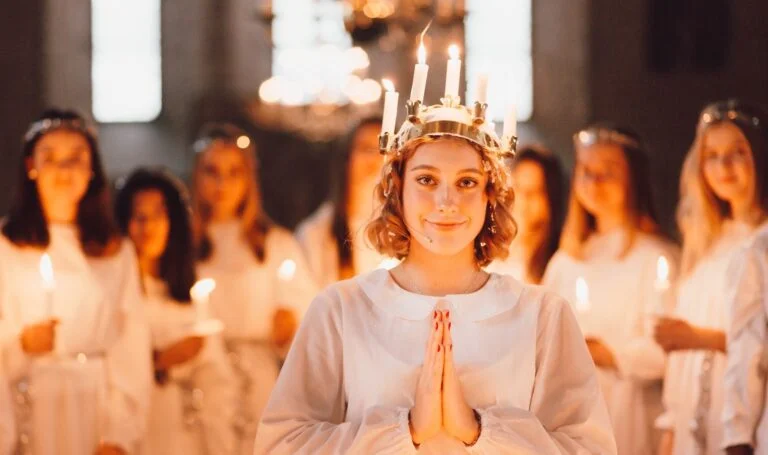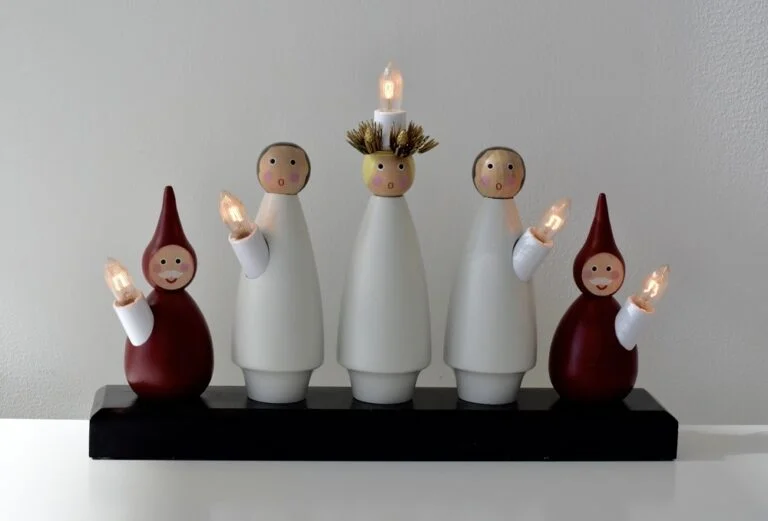In the run-up to Christmas, some people in Norway still observe the day of Santa Lucia, or Saint Lucy. Here’s the story of this Christian tradition.
My heart is swelling with pride and emotion. It’s already dark outside despite the early hour, but the trees glitter with lights and there is music in the background.

I have managed to wrestle my 5-year-old son into a white dress and he is walking along, holding a lit candle in one hand and a saffron-scented bun studded with raisins, sticky from being squashed in his little hand, in the other. ‘For you, mamma’, he says, handing me the sticky yellow bun. ‘For Santa Lucia day.’
Santa Lucia in the Nordics
December 13th is recognized and celebrated as Santa Lucia Day (Saint Lucy’s Day) throughout the Nordic countries.
The Swedes involve young adults and teens in the celebration, but in Norway, Santa Lucia is mainly an event for (young) children, organised in lower elementary schools and kindergardens.
By mid-November, you'll find a small assortment of old-fashioned, frilly white nightgowns in most mid-range children’s clothes stores. On December 13th, you’ll understand why.
Read more: Christmas Traditions in Norway
Small children are dressed up in white cotton outfits walk in a wobbly parade, handing out yellow buns and holding – or wearing! – lights while singing the song Santa Lucia.

It’s lovely, really, you can see a video of Norwegian children here, or the older, Swedish, Luciaparaders here. Just be warned, the song is extremely catchy, and you may find yourself humming ‘Saaanta Luciiiiiaaaaaa’ all night long.
Why do we celebrate? As with so many things on the Norwegian calendar of annual events, ‘tradition’ is an accurate answer, but of course there is a story:
Who was Santa Lucia?
Lucia was a young Christian girl, born in Sicily in the year 283. Dedicated to help people, she took food and drinks to the poor, carrying a candle on her head to have both hands free.
According to history, Lucia was determined to remain unmarried, devoting her life to God. However, the Roman emperor had recently banned Christianity, and Lucia’s mother had promised her hand in marriage to a rich bloke who likely had many great qualities, but sadly for Lucia, Christian faith wasn’t one of them.
Lucia, unsurprisingly, resisted her mother’s plan. Out of the blue, mum became seriously ill, and Lucia was able to miraculously heal her. In return, she asked to be freed from the obligation to marry the heathen.

Mum agreed and let Lucia off the hook as far as the impending marriage was concerned. Lucia was delighted, the fiancé less so. He was, apparently, so ticked off that he ratted her out as a Christian to the Roman Emperor, who sentenced her to work in a brothel (yes, really!)
When the soldiers came to collect her, she was rooted to the ground and could not be moved. The soldiers tried to burn her instead, but alas, she turned out to be impossible to alight, too. Falling, eventually, to a soldier’s sword, Lucia died a martyr on December 13th 304. She is now a patron saint of Syracuse and helper of the blind.
From the Winter Solstice to Santa Lucia
Is that it? Well, no. Where Italy had Lucia, we had Lussi…
Norwegians embraced Christianity more or less voluntarily when King Olav Haraldsson declared it an official religion around 1020. Religious transformation didn’t happen overnight, though, and often, pre-Christian traditions and rituals were ‘tagged on’ to new religious ones.
Before anyone in Norway ever heard of Lucia, we marked the winter solstice, set to December 13th, on the Julian calendar. Winter solstice, the longest night of the year, was believed to be dangerous, and everyone should stay safely inside. The night was referred to as Lussinatta, named after a curious mythical creature, called Lussi.

Indeed, the Santa Lucia song goes:
Svart senker natten seg, i stall og stue. Solen har gått sin vei, skyggene truer, which translates:
Black, the night will fall upon the stable as well as the house. The sun has vanished, and the shadows are lurking.
The mythical creature Lussi lurked around the forests and farms and was known to always be on the look-out for naughty children. ‘Naughty’ housewives were also on the radar for Lussi; evidently, she was tasked with checking up on the progress of important household tasks.
Of extraordinary farm animals and baked goods
Lastly, and perhaps most curiously, farm animals held the power of language during Lussinatta in some parts of Norway, according to Marit Anne Hauan of Tromsø Museum.
Farm animals gathered on this particularly long night to discuss the events of the year to come – in intelligible human language. Any human who overheard these surreal conversations between, say, the cow and the chicken, would lose his mind. I’m not surprised!
I don’t have an explanation for the lovely saffron buns, or Lussekatter, that are eaten for Santa Lucia day beyond that they are yellow, from saffron or turmeric, like the sun we hardly see all winter.
Historical reasons aside, baked goods in winter are never wrong. After all, it’s koselig.


I am of both Swedish and Norwegian descent and I loved hearing about the holiday traditions and history.
“Norwegians embraced Christianity more or less voluntarily when King Olav Haraldsson declared it an official religion around 1020.”
The ‘more or less’ is doing a lot of the heavy lifting in that sentence.
Although perhaps, ‘become Christian or die’ was considered to be voluntarily 1000 years ago. However, by any modern standards, Norway became a Christian country by the sword.